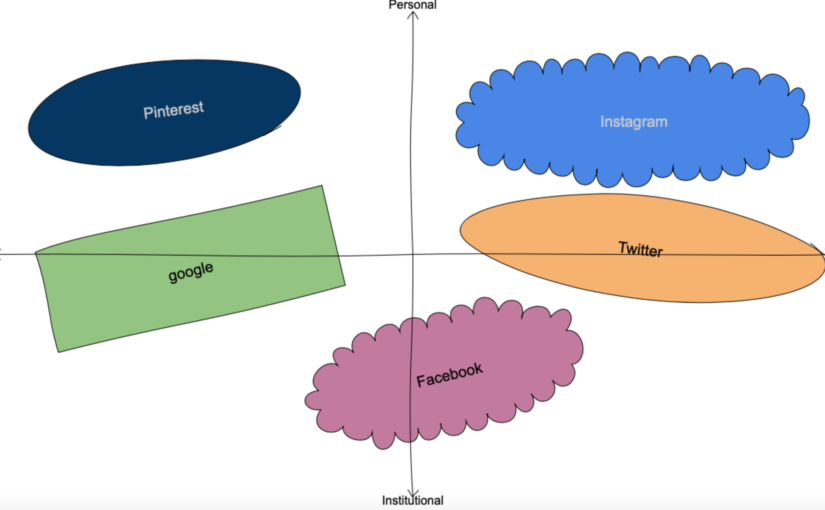-
-
-
- Explore the video provided and reflect on the themes and questions above, reflecting on how you would curate your social media with a critical public audience.
No one can be invisible on the internet; almost all of your footprints and speeches are tracible. Although it is unethical and illegal to reveal private information, what you have expressed and participated in is mostly exposed on the internet. As long as you participate on social media, your comment and trace can be searched and viewed by other people unless you encrypt and intentionally hide your information. Therefore, we need to be aware of everything to form our digital identity, especially our speeches. Suppose our employer or other authorities saw our inappropriate moves on social media. In that case, it will affect their judgment of you as a person and even damage your career or social credit.
To avoid a negative digital identity with a critical public audience, we need to make sure our words are benevolent while representing who we are and our values. First, we need to express our political standing appropriately concerning those who hold opposite standings. It is okay to have a different political standing from others. However, if you express your political attitude in an over radical way or disrespect people with a different view from you, a critical audience on social media might doubt your respectfulness and tolerance. The possible outcome of revealing extreme political views in intensive ways can be your employer reevaluate your ability and suitability to work and interact with others. Second, cyber-bullying and abuse one’s character on social media.
Similarly, your malevolence online and mean comment lets your employer deny your ability to be socially adjusted. Third, to show that you are dedicated and professional in your intended field, you can actively engage in discussions and participate in related online activities to represent your dedication and professionalism. Forth, another harmful thing to do on social media is sharing your colleagues’ and your employers’ disreputable stories; these acts can frustrate your employer or other people about your sense of boundary. Overall, we need to be mindful of what we are sharing online and think twice about whether it will harm our digital identity or even reputation.
-
-
-
- Identify the risks and benefits of engaging with a public audience in a media space – what are the risks for a public figure or person in a position of trust (educator, lawyer, government official)?
For a public figure or person in a trust position, being in the public eye in a public media space is beneficial because it exposes the person to more professional and works opportunities. The opportunities include creating an integrated figure of yourself to be accepted and become a public influencer to share the influence related to your profession. When you persist in actively sharing meaningful insights in a particular field, naturally, the audience is willing to discuss their knowledge regarding the field. This type of engagement can benefit your learning and build a reputation.
Nevertheless, once you have created an integrated figure of yourself, an increasing number of people will notice you. Due to a critical audience’s close attention, potential threats can be people going on the internet to find your skeletons from the past and even twist the truth as a weapon against your reputation. With the tracible speeches and online footprints, it is easy for people to persecute a reputed public figure exposed through media, and it could potentially harm one’s profile, reputation, and career.
-
-
-
- How do notable individuals use social media?
Public figures that stand out have different ways of utilizing their social media. Most treat social media as a platform to do personal branding. By sharing photos or written passages, public figures build up characteristics to their digital identity on personal and marketing levels. Figures promote themselves by adding traits, personalities, and uniqueness to stand out, attract followers, and ultimately monetize the hard work of forming their digital identities both directly and indirectly. For example, NowThis, a social journalism firm, posts videos of global news sourced on other news on social media, forming an unofficial news collection channel nurtured by social media, with some journalism professionals’ contribution (Hirst, 142). NowThis is tending to profit through doing brand collabs and so on (Hirst, 142). Similar to NowThis, many public figures are intended to monetize their account directly by promoting profitable brands or indirectly by promoting themselves as a potential affiliate to an existing organization or company.
Also, notable individuals who have their own brand or are working for a brand often utilize social media to expose and thus promoting their brand. Usually, suppose the founders of the brand decided to be a social media influencer. In that case, they dedicate to making their digital identity stand out, meanwhile tie their digital identity with their brand to create a bonus effect in attracting purchases and providing some light customer relationship management.
-
-
-
- What are the benefits to being in the public eye and having a PLN?
Being in the public eyes means more attention; having a PLN means having wider learning opportunities. These two features put together can create an effect of excellent learning outcomes. Because when more attention is attracted, more people tend to participate and join the PLN, which leads to more fruitful knowledge sharing, a large community of PLN is thus created. Therefore, the benefit of having a PLN can be largely enhanced with the attention of the public eye.
-
-
-
- Building community with online tools provided by the employer can be limiting, what are the perceived restrictions and benefits?
When an employer builds an online community, their purpose is to trigger work-related discussions and perhaps monitor employees’ working enthusiasm. This perceived intention can encourage employees to participate in concentrated and centralized discussions to assist their professional learning of professional skills and instant industrial insights. On the other hand, however, the employer’s monitorization causes the community to be a not entirely comfortable environment for sharing.
-
-
-
- Delivering information in a connected society requires verifiable resources, how to build a PLN to rely on?
In order to build a trusted PLN, we first need to share our insights. Before you start to share your content, you do not provide a reason for others to share their knowledge with you. Building a PLN is always about giving and taking, selecting the people you are intended to connect and starting by sharing your own content (Lynch, 2017). Nevertheless, no one is professional in a field at the very beginning; if you have not gained enough knowledge in the intended field, it may be helpful to first introduce yourself as a modest learner and share some genuine thoughts and personal experience. Making such a genuine impression to as many people as you can ultimately will attract helpful professionals to share their meaningful insights with you.
-
-
-
- How do those, who are veteran story tellers, minimize risk in sharing misinformation?
People who are experienced in sharing professional knowledge or stories are often careful of the authenticity of the information. The reason for that is, they are fully aware of the danger of sharing incorrect messages and the harm it could do to one’s career. As a result, before they share, they make sure the content they share have a trusted original source. They would identify the credibility of the source and critically inspect if there are any suspicious details. Identifying a source includes the provider’s ethos and trustworthiness who first communicates the story and then verify if the view or story has the probability of being altered for private interest. After verifying the credibility of a source, the veterans give credit or cite the trusted source. Even if the information or story were then proven incorrect, the person who shares and gives credit to the source is often pardoned from the mistake’s responsibility. When people are not sure of the source, it is always helpful to clearly state the information’s uncertainty before sharing it. Once the information or story is proven to be misleading, the veterans would immediately address the issue clarify with the correct information.
References
-
-
-
- Lynch, Matthew. “How to Create Your Own Personalized Learning Network.” The Edvocate, 13 Aug. 2017, www.theedadvocate.org/create-personalized-learning-network/.
- Hirst, Martin. Navigating Social Journalism: a Handbook for Media Literacy and Citizen Journalism. Routledge, 2019.

